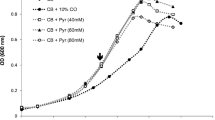Summary
The metabolic relationship between the solventogenic state in Clostridium acetobutylicum and intracellular NADH levels was investigated using culture fluorescence as a technique for continuous monitoring of in vivo NADH levels. Continuous culture experiments showed that a transition from acidogenic to solventogenic state was accompanied by a decrease in culture fluorescence, which was interpreted as a decrease in NADH level. It appears that NADH/NAD+ turnover rates may be more significant than NADH levels in determining the metabolic state of the cell. This result provides important new information on regulation of the intracellular reduction state in Clostridium acetobutylicum. Culture fluorescence is shown to be a useful technique for non-invasive on-line monitoring of the metabolic state in continuous acetone-butanol fermentations.
Similar content being viewed by others
References
Adams MWW, Morenson LF, Chen JS (1981) Hydrogenase. Biochim Biophys Acta 594:105–176
Chance B, Estabrook RW, Ghosh A (1964) Damped sinusoidal oscillations of cytoplasmic reduced pyridine nucleotide in yeast cells. Proc Nat Acad Sci USA 51:1244–1251
Datta R, Zeikus JG (1985) Modulation of acetone-butanolethanol fermentation by carbon monoxide and organic acids. Appl Environ Microbiol 49:522–529
Doremus MG, Linden JC, Moreira AR (1985) Agitation and pressure effects on acetone-butanol fermentation. Biotechnol Bioeng 27:852–860
Duysens LNM, Amesz J (1956) Fluorescence and spectrophotometry of reduced phosphopyridine nucleotide in intact cells in the near-ultraviolet and visible region. Biochim Biophys Acta 24:19–26
Ennis BM, Gutierrez NA, Maddox IS (1986) The acetone-butanol fermentation: a current assessment. Proc Biochem 21:131–147
Gray CT, Gest H (1965) Biological formation of molecular hydrogen. Science 148:186–192
Harrison DEF, Chance B (1970) Fluorimetric technique for monitoring changes in the level of reduced nicotinamide nucleotides in continuous cultures of microorganisms. Appl Microbiol 19:446–450
Huang L, Gibbins LN, Forsberg CW (1985) Transmembrane pH gradient and membrane potential in Clostridium acetobutylicum during growth under acidogenic and solventogenic conditions. Appl Environ Microbiol 50:1043–1047
Jones DT, Woods DR (1986) Acetone-butanol fermentation revisited. Microbiol Revs 50:484–524
Jungermann K, Thauer RK, Leimenstoll G, Decker K (1973) Function of reduced pyridine nucleotide ferredoxin oxidoreductase in saccharolytic clostridia. Biochim Biophys Acta 305:268–280
Kim BH, Bellows P, Datta R, Zeikus JG (1984) Control of carbon and electron flow in Clostridium acetobutylicum fermentations: utilization of carbon monoxide to inhibit hydrogen production and to enhance butanol yields. Appl Environ Microbiol 48:764–770
London J, Knight M (1966) Concentration of nicotinamide nucleotide coenzymes in micro-organisms. J Gen Microbiol 44:241–254
Meyer CL, Roos JW, Papoutsakis ET (1986) Carbon monoxide gassing leads to alcohol production and butyrate uptake without acetone formation in continuous cultures of Clostridium acetobutylicum. Appl Microbiol Biotechnol 24:159–167
Monot F, Engasser JM, Petitdemange H (1983) Regulation of acetone butanol production in batch and continuous cultures of Clostridium acetobutylicum. Biotechnol Bioengg Symp 13:207–216
Papoutsakis ET (1984) Equations and calculations for fermentations of butyric acid bacteria. Biotechnol Bioengg 26:174–187
Petitdemange H, Cherrier C, Raval G, Gay R (1976) Regulation of the NADH and NADPH-ferredoxin oxidoreductases in Clostridia of the butyric Group. Biochim Biophys Acta 421:334–347
Rao G (1987) Directed metabolic flow in Clostridium acetobutylicum. Ph. D. Thesis. Drexel University, Philadelphia, PA
Rao G, Mutharasan R (1987) Altered electron flow in continuous cultures of Clostridium acetobutylicum induced by viologen dyes. Appl Environ Microbiol 53:1232–1235
Reardon KF, Scheper T, Bailey JE (1986) In situ fluorescence monitoring of Clostridium acetobutylicum. Biotech Lett 8:817–822
Reardon KF, Scheper T, Bailey JE (1987) Metabolic pathway rates and culture fluorescence in batch fermentations of Clostridium acetobutylicum Biotechnol Prog 3:153–167
Author information
Authors and Affiliations
Rights and permissions
About this article
Cite this article
Rao, G., Mutharasan, R. NADH levels and solventogenesis in Clostridium acetobutylicum: New insights through culture fluorescence. Appl Microbiol Biotechnol 30, 59–66 (1989). https://doi.org/10.1007/BF00255997
Received:
Accepted:
Issue Date:
DOI: https://doi.org/10.1007/BF00255997




